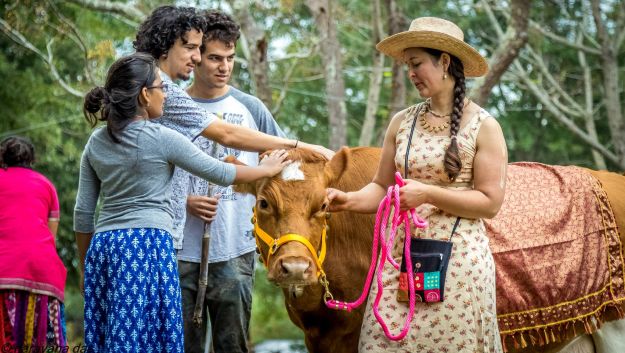Mississippi Kirtan Mela Promotes Cow Protection
By Madhava Smullen | Oct 15, 2015

This year’s Save the Cow Kirtan Mela at ISKCON’s New Talavana farm in Mississippi drew around one thousand locals and devotees over the weekend of October 9th to 11th for a family-oriented festival centered around cow care.
The event raised awareness of the cow’s plight in modern society, promoted cow protection, and raised funds for New Talavana’s own cow care program, which has protected cows throughout their natural life since 1976. It currently has a herd of sixty.
The Mela was the ninth annual Cow Fest at New Talavana, and the second year a 24-Hour Kirtan has been added to the festival – an idea spearheaded by second generation devotee organizers like Lalita Garrett, Kalindi Bradley, Nrsimha and Rukmini.
It attracted many ISKCON devotees, members of the yoga community, new age people, animal rights supporters, and locals in general from Mississippi and nearby states Louisiana, Alabama and Florida.

Raghunath Das performs an agnihotra yajna for the protection of the cows
The festivities, which were held under a decorated pavilion outside, kicked off at 5pm on Friday evening with a feast, followed by a Krishna conscious hip-hop performance by Vijay of The Kirtaniyas and DJ Tom Harvey of Wild Lotus Yoga in New Orleans.
“They really engaged the crowd, getting them to sing and dance along, with their rapid rhythms and sweet melodies,” says New Talavana temple president Yogindra Vandana Das. “The evening then wrapped up with a bonfire.”
After the temple program on Saturday morning, participants charged up with a breakfast of granola from Atlanta-based devotee company Pure Bliss and milk from New Talavana’s cows.

Michelle Baker of Swan River Yoga leads a yoga class in the sun
They then took Hatha Yoga with Michelle Baker of Swan River Yoga in New Orleans, who has visited Mayapur and Vrindavana in India, helped with ISKCON’s efforts locally, and ends her sessions by chanting kirtan.
Second generation devotee Raghunath Das from Alachua, Florida, a trained samskara pandit, then performed an agnihotra yajna for the protection of the cows, chanting 108 names of Lord Nrsimhadeva.
At 12pm, the 24 Hour Kirtan began, running until 12pm the next day as a means of praying to Lord Krishna for the protection of His beloved cows. Well-known chanters such as Bada Haridas, Madhava, The Mayapuris, Amala Kirtan, Amala Harinama, the Kirtaniyas, and more led the kirtan before deities of Gaura Nitai and a huge Jagannath murti.

Bada Haridas leads the chanting
“It was a little cold at night, but we stuck it out,” Yogindra says. “We had a nice attendance by devotees from our ISKCON preaching center in Tuscaloosa, Alabama, headed by Nagaraja Das, who took the hard shift from 3:30 to 4:30 in the morning.”
Meanwhile, alongside the 24 hours of kirtan was a fun fair-style family day out, with arts and crafts, face-painting, coloring, balloons, bouncy castles and hayrides for the kids that took them to see the cows. Stalls sold curd burgers, homemade pizza, and panir wraps made with milk from the protected cows, along with New Talavana honey and ghee.

Lining up for curd burgers made from protected cows’ milk
Head cowherd Jayanti, a gurukuli who grew up in New Talavana, showed people how to milk the cows, and let them try it out. People could watch butter-churning demonstrations. And at one booth, devotees cooked subji and chapatis over a cow dung fire and served them out to people.
“We made at least a thousand chapatis before we ran out, and probably used about 10 gallons of panir for the whole festival,” Yogindra says.
On Saturday evening, devotees sent Chinese floating lanterns off into the clear starlit sky as Madhava chanted the Holy Names. And on Sunday, the kirtan moved from the outside pavilion into the temple room with a rip-roaring offering by Badahari Das.

Getting face-painting
The festival ended with a delicious feast prepared by Yogindra’s son Sugosh and his team from their Good Karma Prasad Café in New Orleans, which all participants enjoyed sitting outside under the beautiful blue sky.
During the feast, winners of a raffle to fund cow protection were called out, and won Krishna conscious goody baskets filled with books by Srila Prabhupada and his disciples, New Talavana honey and ghee, Krishna dolls, and more.
“It was a great event that made some profit for the cows, and raised a lot of awareness,” says Yogindra. “It educated locals about learning to appreciate the cows, and how terrible it is that people would slaughter and be cruel to them. It’s amazing to see how people’s awareness is gradually growing every year.”
See more photos here















